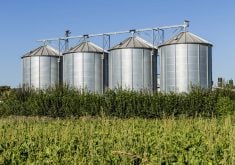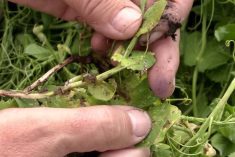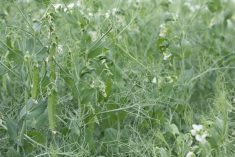Field pea acres have grown steadily in recent years, but 2022 won’t likely bring an increase in production. While acres remain high, agronomists predict yield per acre will take a nosedive.
“We’ve dreamt of a 300,000-acre industry,” said Terry Buss, an agriculture adaptation specialist out of Manitoba Agriculture’s Beausejour office. “Back in 2017, we only had about 65,000 acres and last year we reached 225,000 acres.”
Buss was speaking at a July 26 field day at the Prairies East Sustainable Agriculture Initiative (PESAI) Crop Diversification Centre near Arborg, Man.
Read Also

Still hard to predict precise fertilizer payback
Despite decades of advances, international research finds no clear answer for where and when adding nutrient will fail to boost growth.
Why it matters: Field peas have seen a serious boost with end-users like Roquette coming into the province, but 2022’s return to wetter conditions brought production challenges.
In 2020, field peas reached their highest mark to date in terms of bushels per acre.
“The average yield across the whole province was 57 bushels an acre and, out our way, I had people breaking 80 on their fields,” Buss said.
The reason was simple: 2020 was a dry year for a crop that does not like to have its feet wet. It was the Goldilocks zone for field peas, and was only one amid a series of dry years. The province saw less rain than normal stretching back to 2018.
Last year, however, was a step too far. Production plummeted to an average 36 bushels per acre across the province.
“2020 was one of the driest years I’ve ever experienced,” Buss said. “Then in 2021, it was absolutely the Sahara Desert.
“The thing about field peas is that they’re not drought tolerant. A lot of people talk about them that way, but they’re not a dryland crop. They only explore about the top 18 inches of the soil block, so they are subject to drought fairly readily if it gets dry enough.”
Getting a sense of this year’s field pea conditions has been a challenge. The 2022 season has shown Buss, “everything from soup to nuts.”
“I’m seeing fields where I think we’ve got a yield potential in the 70-bushel area and I’m seeing fields where I think we’ll have a yield in the 19-bushel area, all five miles from each other.”
Drainage
The difference between the two is drainage. While infamous for their drier-soil preference, peas do grow in areas with high moisture.
“They’re quite productive in the U.K., where they’ve got a heck of a lot of water, but they have a heck of a lot of good soil drainage.” Buss said. “They’ve got good internal soil drainage, they’ve got tile drainage, they have a very mature drainage system.
“So this year, the biggest limit on field pea yield that I’m seeing is soil structure, soil drainage and internal drainage.”
Peas planted in well-drained fields or those with lighter textured soils are looking good this year, agronomists have noted. However, crops planted in dense soils on poorly drained fields are not faring so well.
“We have a real problem with that back in Beausejour,” Buss said. “If they’re on the kind of gumbo that makes up most of our area, they’re doing really poorly. They’re really polluted with root rot.”
Plants are shrivelling before filling pods, he noted, and he expects to lose 50 to 75 per cent in many of those fields.
Buss stressed the importance of location when planning for field peas. Think about soil type and remediating excess moisture, he advised.
Spring prep
Seeding date is another important factor in maximizing yield potential. Field peas germinate in cool soils and don’t like flowering when it’s hot, so early planting is optimal.
“We find that once we push our seeding date back to that last week of May, potentially we could be losing about 20 per cent of the yield,” Buss said.
According to the May 31 Manitoba Agriculture Crop Report, only 75 per cent of field pea acres were planted in western Manitoba by the end of that month, and persistent rains saw seeding delayed even further in the central, eastern and Interlake regions. Late seeding is considered a contributing factor to this year’s low yield projections.
“Optimum density is about seven to eight plants per square metre,” Buss added. “If you get over that, you’re just wasting your money. You’re not getting increased yield, but you are spending more on seed.”
On the other hand, density of three to four plants per square foot means crops are unlikely to reach their yield potential and will have a tough time competing with weeds.
“I carry this goofy hula hoop all the time,” Buss said. “It’s got a diameter of 28 and a quarter inches. That’s really important. If I count between 30 and 34 field peas in this hoop, I’ve got the right density to maximize yield.”
Early weed control is crucial, Buss said.
“In the research that’s been done, if you’re three weeks late from the earliest opportunity you could spray, you’ve probably lost 15 to 25 per cent of your yield.”
And because field peas are generally seeded early, herbicide performance becomes a concern, since plants must be actively growing to take up chemical.
“We have to be careful in terms of how cold it is when we’re spraying. But we definitely want to be on removing our weeds from the stands as soon as we can, because it’s the first ones that show up that are the problem.”
While the numbers aren’t tallied yet, Buss said he expects acres will reach about 200,000 this year.
















